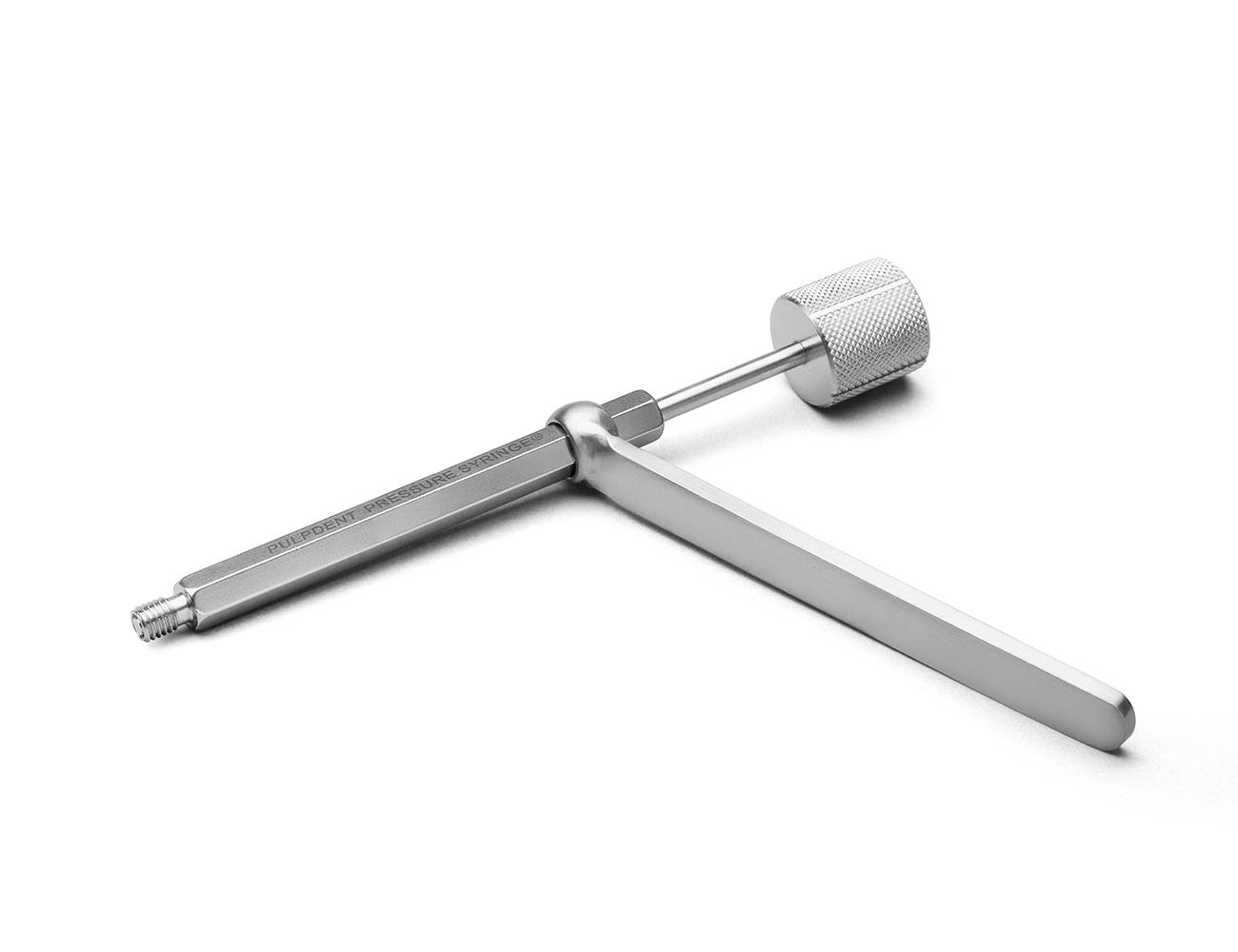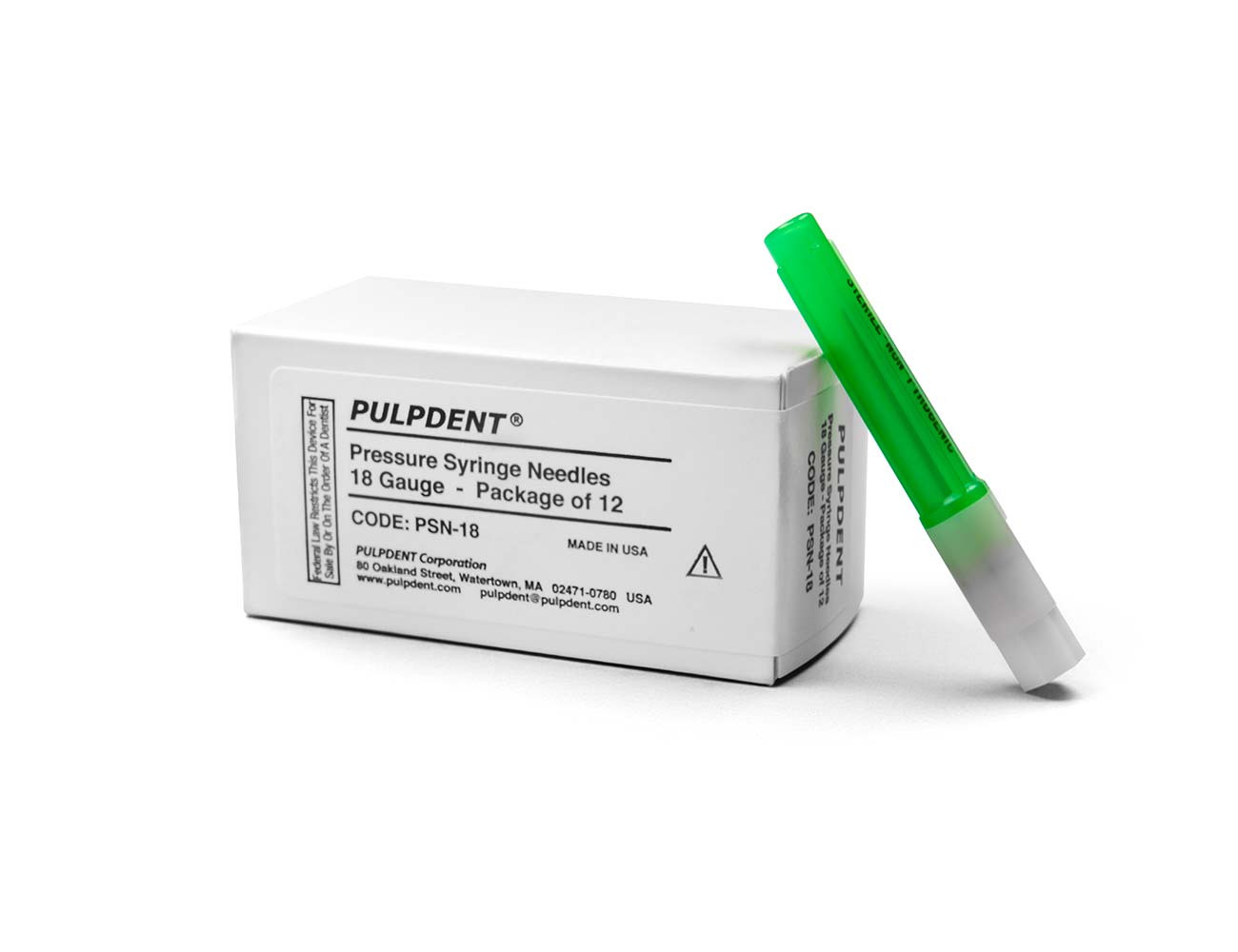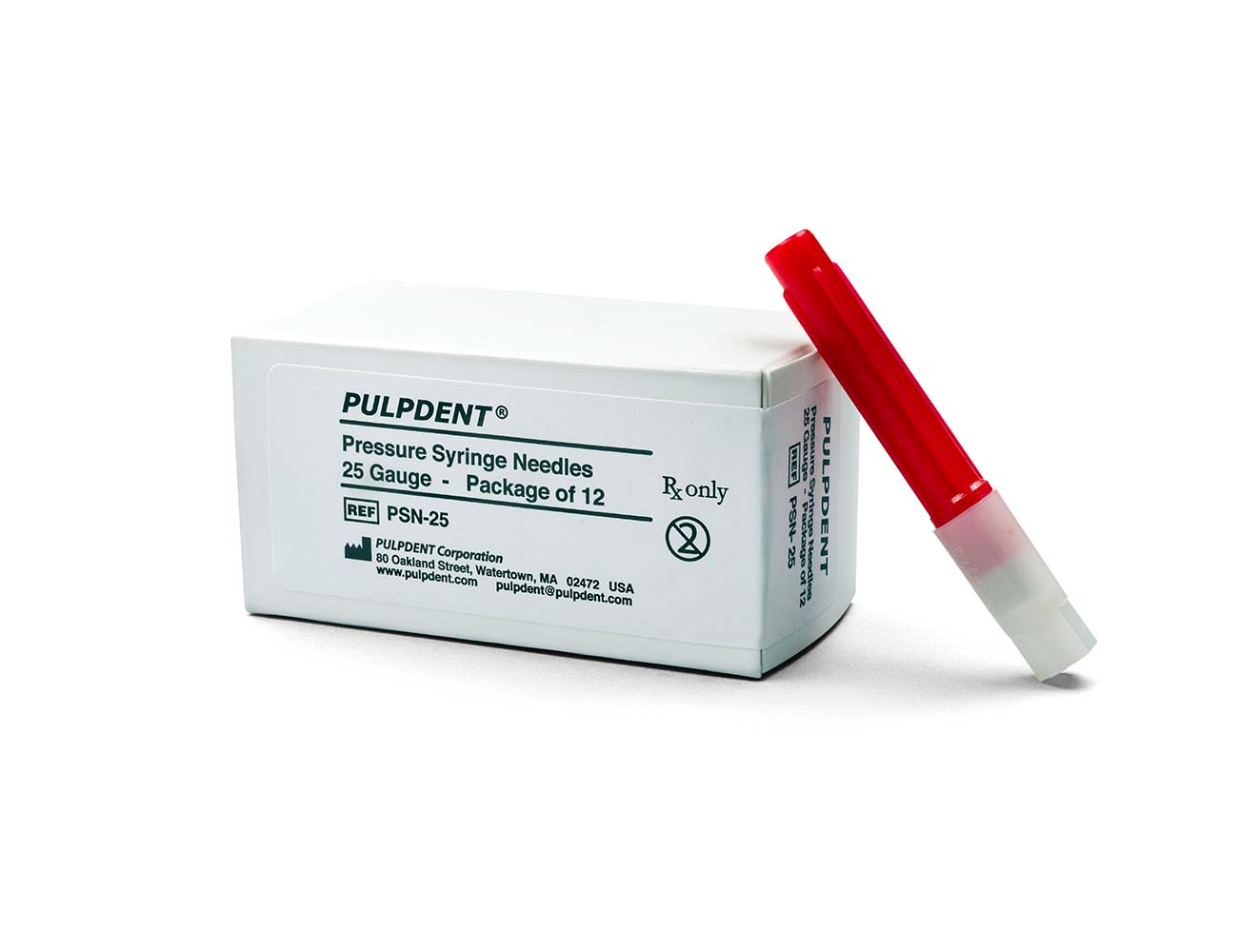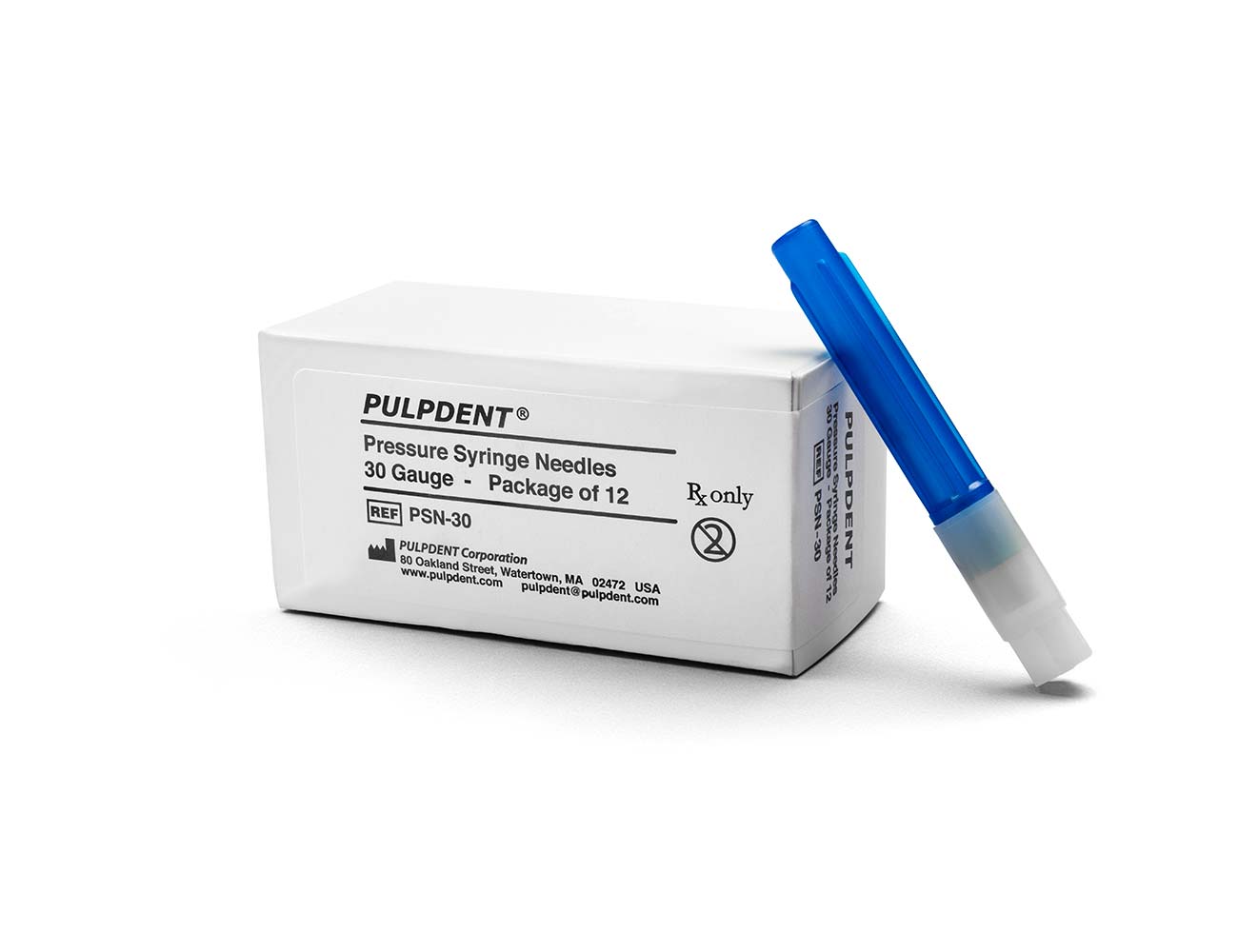Accessoire pour l’endodontie
Description :
45 ans de succès clinique
Le dispositif original de seringue à pression pour le remplissage des canaux radiculaires
Cette seringue haute pression offre toujours la méthode la plus précise pour obturer les canaux radiculaires avec le Pulpdent Root Canal Sealer. Remplissez d’abord l’apex pour créer un scellement positif, puis remplissez avec précision l’espace restant du canal à l’aide d’aiguilles émoussées de calibre 30, 25, 22 ou 18 gauge. Fabriqué en acier inoxydable. Stériliser par n’importe quelle méthode.
Pour obtenir des instructions sur la stérilisation des instruments dentaires cliquez ici.
Références :

PSO – Seringue haute pression

PSN-18 – 12 aiguilles, 18 ga

PSN-22 – 12 aiguilles, 22 ga

PSN-25 – 12 aiguilles, 25 ga

PSN-30 – 12 aiguilles, 30 ga
Articles et Références
- Berk H, Krakow AA. The Endodontic Pressure Syringe. CDS Review 1975;68(9):20-23.
- Krakow AA, Berk H. Efficient endodontic procedures with use of the pressure syringe. Dent Clin N A 1965;9:387-399.
- Berk H. Save That Tooth. Watertown, MA: Pulpdent Corporation, 2005.
- Mehlman ES. Clinical article: management of a totally fused central and lateral incisor with internal resporption perforating the lateral aspect of the root. Oral Health 1979;69(7):30-33.
- Serota KS, Krakow AA. Retrograde instrumentation and obturation of the root canal space. J Endo 1983;9(10):448-451.
- Berk H, Pameijer CH. Endodontic usage and extrusion evaluation of a zinc oxide and eugenol based endodontic sealer. Endod Pract 2011;14(1):7-12.
FAQs
- Q What are the contents of the Pressure Syringe Kit?
A: The Pressure Syringe Kit consists of the Pressure Syringe, handle, 30 assorted sterile, blunt assorted Pressure Syringe Needles (18, 22, 25 and 30 gauge), Pulpdent Root Canal Sealer Kit, and Wonder Orange Cleaning Solution. The Pressure Syringe is made of stainless steel and can be sterilized by any method. All components are available separately in a variety of packaging options.
- Q: What are the ingredients of Pulpdent Root Canal Sealer?
A: The powder contains zinc oxide, zinc stearate, calcium phosphate and barium sulfate. The liquid contain eugenol and Canada balsam.
- Q: Is Pulpdent Root Canal Sealer the only material that can be used with the Pressure Syringe?
A: Pulpdent Root Canal Sealer is the recommended material. It is milled to a very fine particle size so that a thick mix flows through a 30-gauge needle. It is slow setting and will not set in the Pressure Syringe during use. Do not use zinc oxide and eugenol; it sets too quickly.
- Q: Can Pulpdent Root Canal Sealer be used alone as a final filling material in permanent teeth?
A: Yes. Pulpdent Root Canal Sealer is indicated for use alone as a permanent root canal filling material or in conjunction with gutta perchAnswer:
- Q: Can Pulpdent Root Canal Sealer be used in deciduous teeth?
A: Yes. Pulpdent Root Canal Sealer resorbs with the roots of deciduous teeth and is recommended for this purpose.
- Q: Is it possible for the Pressure Syringe Needle to clog?
A: It happens very rarely. If the Pressure Syringe was not properly cleaned, dried sealer particles can cause a needle to clog. If pressure is building up in the syringe and sealer is not extruding, discard the needle, clean the Pressure Syringe, and make a new mix of sealer. The Pressure Syringe is designed so that excessive pressure cannot dislodge the needle from the syringe.
- Q: If sealer extrudes from the threads of the Pressure Syringe instead of through the needle, what should I do?
A: If sealer extrudes through the threads, either the sealer was not mixed to a thick enough consistency, the screw plunger is being turned to fast, or the needle was blocked by a hard particle of cement remaining in the syringe from previous use. Always mix the sealer to a creamy, putty-like consistency, yet pliable enough to form a homogeneous mass, turn the screw plunger slowly allowing sufficient time for the material to extrude through the small gauge needle, and clean the syringe well after every use.
- Q: How do I prevent sealer from coming out of the canal in a coronal direction when I am withdrawing the Pressure Syringe needle?
A: The assistant should hold a cotton pellet in the access cavity against the side of the needle while the needle is being withdrawn.
- Q: What happens if sealer is extruded through the apex?
A: Pulpdent Root Canal Sealer is tissue compatible. Slight overfills often resorb in 10-12 months.
- Q: Can the sealer be forced into the mandibular canal?
A: The Pressure Syringe technique calls for giving one-quarter turn at the apex and then backing off the needle to break contact with the sidewalls of the canal. This step is critical and will always prevent gross overfills into the mandibular canal. Continued turning of the plunger without withdrawing the needle to break contact with the sidewalls of the canal is dangerous and could force sealer into the mandibular canal.
- Q: How do I correct an incomplete fill at the apex?
A: If a radiograph shows an incomplete fill at the apex, take the last file used and push it straight into the canal to 1-2 mm from the apex. Remove the file by rotating it counterclockwise. Reinsert the Pressure Syringe Needle to a distance 1-2 mm from the apex, and with an assistant holding a cotton pellet against the side of the needle at the orifice, turn the screw plunger clockwise while slowly withdrawing the needle. This will fill the space created by the file. After filling, force a cotton pellet into the orifice of the canal for vertical condensation. Take another radiograph.
- Q: How do I correct an incomplete fill in the canal?
A: An incomplete fill in the canal is usually caused by withdrawing the needle too fast during the filling procedure. Correct this situation by pushing the needle back into the canal to the desired depth, and with an assistant holding a cotton pellet against the side of the needle at the orifice, turn the screw plunger clockwise while slowly withdrawing the needle. After filling, force a cotton pellet into the orifice of the canal for vertical condensation. Take another radiograph.
- Q: How can I achieve lateral condensation?
A: After filling the canal with Pulpdent Root Canal Sealer, a gutta percha point can be placed in the canal with a root canal plugger for lateral condensation.
- Q: How can I achieve vertical condensation?
A: After filling, use a cotton pliers or similar instrument and force a cotton pellet into the orifice of the canal, or force a round piece of gutta percha into the canal for vertical condensation. This method often picks up and obturates accessory canals and multiple apical openings.
- Q: How do I fill a canal when there is a large periapical lesion?
A: Before placing the final filling, we recommend treating periapical lesions with Pulpdent Paste, TempCanal, MultiCal or Forendo Paste to stimulate periapical healing, which usually occurs in 2-3 months. After healing occurs, final obturation of the canal is routine.
- Q: How do I fill canals with internal resorption?
A: Use a diagnostic x-ray to determine the distance to the area of internal resorption. Fill the canal to the beginning of the internally resorbed area, using the standard technique. Hold the needle in the area of internal resorption, and turn the screw plunger until the sealer appears in the access cavity. The sealer will flow into the internally resorbed area.
A: Teeth with bent roots or tortuous canals can usually be negotiated and enlarged by using EDT
A: When this is not possible, place the Pressure Syringe with a 30-gauge needle into the canal as far as it will go. Measure the distance and determine the length of the canal beyond the end of the needle. Estimating that ¼ turn of the screw plunger will fill 2 mm of canal space, conservatively estimate how far to turn the screw plunger, and fill the apical portion of the canal. Place the last file used back into the canal as far as it will go with a straightforward thrust. Take a diagnostic x-ray. If necessary, reinsert the Pressure Syringe and place more sealer in the apical portion of the canal; otherwise, fill the remaining root canal space by turning the screw plunger clockwise while slowly withdrawing the needle. Vertical condensation with gutta percha and a plugger, or a combination of gutta percha and root canal sealer, will usually complete the obturation of the root canal space.[/vc_list_item]

